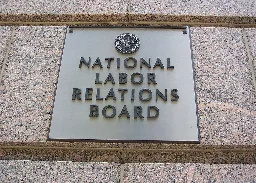It’s Not Looking Good at the National Labor Relations Board
It’s Not Looking Good at the National Labor Relations Board
The future of labor law has rarely looked so perilous for unions.

cross-posted from: https://sh.itjust.works/post/31013935
December saw a number of important developments at the National Labor Relations Board (NLRB). The month started well for unions but ended badly. Some observers complained of whiplash!
On December 10, the five-member board, still under Democratic control, issued a long-awaited decision freeing unions from the most deleterious features of management-rights clauses.
The case, Endurance Environmental Solutions, LLC, overruled MV Transportation, a 2019 decree from Donald Trump’s first term in office.
MV Transportation created an outrageous presumption that unions that agree to generally worded management-rights clauses intend to give employers a right to change work rules, hours, or other conditions of work without giving prior notice or extending an opportunity to bargain.
Since most labor agreements have broad management-rights language, MV Transportation had a devastating impact, allowing employers to cancel important rights and benefits without fear of legal challenge.
When Joe Biden won the presidency in 2020, union activists hoped that he would soon nullify MV Transportation by restoring activist Democratic control of the NLRB. They cheered when Biden’s first picks, Democratic SEIU lawyers David Prouty and Gwynne Wilcox, formed a majority along with incumbent Democratic chairperson Lauren McFerran.
Disappointment gradually followed, however, as for almost five years the Biden labor board failed to take aim at management rights. With only a few weeks left in Biden’s term, the board finally came through.
Endurance Solutions squarely reversed MV Transportation, stating that “management-rights clauses that are couched in general terms and make no reference to any particular subject area will not be construed as waivers of the statutory right to bargain over a specific subject.”
This holding reduced the legal significance of most management-rights clauses to little more than vague statements of philosophy.
It did not take long for Republicans to hit back with a vengeance. On December 11, without a legitimate basis in her record, the Senate rejected President Biden’s routine renomination of Chairperson McFerran to a second five-year slot on the board.
McFerran’s confirmation would have cemented a Democratic Board majority until at least 2026. Her rejection will give Trump the ability to nominate her replacement as well as fill an existing vacancy, giving the Republicans a decisive 3–2 majority.
To win the vote against McFerran, the Trump forces needed at least one independent or Democrat to vote with the forty-nine Republicans. Mavericks Kyrsten Sinema (I-AZ) and Joe Manchin (I-WV) quickly lent their support, quashing the nomination fifty to forty-nine (one Republican didn’t vote).
Once Trump’s next set of nominees are confirmed, we can expect them to try to reverse several pro-union precedents. These include:
Stericycle, which imposed strong standards against chilling employer rules and policies; Cemex, which in some cases compels employers to recognize union majorities without an election; Amazon, which largely bans captive-audience anti-union meetings; And, of course, the newly inked Endurance Environmental Solutions. From a union standpoint, the future of labor law has rarely looked so perilous.
Questions and Answers Q. We work for the state of California. Do changes in NLRB policies affect us?
A. Yes, but not directly. The National Labor Relations Act only has jurisdiction over private sector employers and employees. Federal and state agencies come under the supervision of public sector labor boards. Nonetheless, these bodies often look to the NLRB for direction.
Q. Could Donald Trump fire all the existing Democratic members of the Board as well as Democratic administrative law judges (ALJs)?
A. For years, the answer to such a question was a strong no, based on constitutional principles, free speech, and due process. Recent litigation, however, suggests that some federal judges may be receptive to granting the president new levels of control over personnel decisions. The issue is likely to bubble over in the years ahead.
Q. We hear that some employers are asking courts to rule that the National Labor Relations Act (NLRA) — our fundamental federal labor law, passed in 1935, which gives workers the right to form unions and take collective action — is unconstitutional. Is there any strength to the argument?
A. Hard to say. The US Supreme Court upheld the constitutionality of the NLRA in 1937. Nonetheless, in recent years, Amazon, SpaceX, and Trader Joe’s have railed against it, contending that the NLRB has too much power. Most observers believe the argument lacks merit, even if a sympathetic Supreme Court hears the matter.
Moreover, the ruling class takes a chance by gutting the NLRA — workers and unions may press for their demands in the streets, a venue where they have the advantage.
Q. If the NLRB keeps turning to the right, should unions continue to file unfair labor practice charges and election petitions?
A. Yes — unless the NLRB goes completely over to the dark side. Even if the board becomes ultraconservative, hundreds of decent ALJs, hearing officers, and enforcement personnel will continue giving unions a fair shake.
Moreover, if the minority Democratic board members use stalling tactics, as can be expected, employers may not be able to reverse major labor principles for several years; it took five years before a Democratic majority was able to overturn MV Transportation.
In the meantime, unions may be able to win tactical victories while building a united front to save the labor agency from total capitulation.